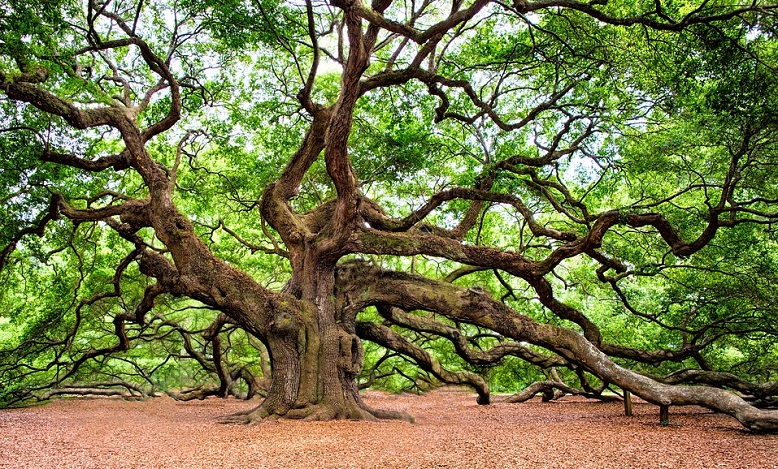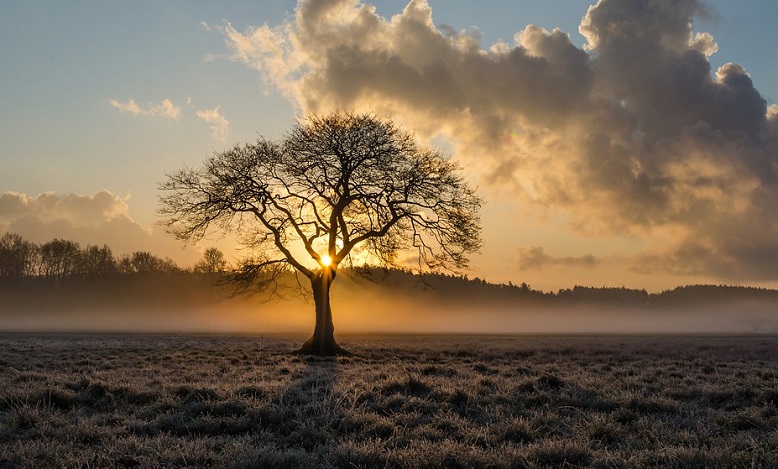The oak symbolizes strength, longevity, and hardness.
The oak is a tree of long life and belongs to the strongest species of plants.
It was considered the sacred tree by many peoples, including the Celts, the ancient Jews, the Greeks and the Romans.
In Abraham’s time, wizards grew up in the shade of Shechem’s oak, who interpreted the signs from the rustling of leaves and the cooing of doves, for the spirit was instilled in the trees.
Oak Tree as a symbol in Cultures
Under a sacred oak tree, Sibilla announced her prophecies. The Druids practiced their worship in the midst of oak forests. The ancient Greeks owned an oak tree from Zeus (Jupiter).
Even the famous Hercules mace was made of oak wood. The Romans considered the oak tree as belonging to Jupiter. The temple of Baal, preserved in Damascus, was built in an oak grove.
The sacred oak surrounded Abel’s tomb. Thanks to its enormous size and great longevity, the oak in the mythology of many peoples was mythologized as the king of the forest, and therefore, often dedicated to the supreme deities (Zeus, Jupiter, Perun, that is, to the gods of thunder; there was the belief that lightning strikes the oak more often).
It is an oak plank; this attribute is used for the supreme deities or solar, and symbolizes the power of power. Because of its close relationship with the Thundering God, oak is often associated with a military theme, in fact, a garland of oak leaves is used in military insignia. The cult of the oak belonged to all the European peoples: Etruscans, Romans, Scandinavians, Slavs, Germans, etc.
In its same etymology the name of the Druids, the Celtic priests, is associated with the oak. It was also a tree sacred to the Jews, who idolized it as an eternal plant (since from the root of a dry tree, according to legend, there are no new shoots). Sometimes an oak tree represents the world.
For example, in ancient Greek myth the Golden Fleece (symbol of fertility and prosperity) was described hanging from an oak tree and with the serpent that protected it (chthonic creature, a solar opponent hero), in which the main reason of the legend recalled echoes of Indo-European tradition.
The fleece hanging from the oak is considered useful because it increases it. Moreover, the oak is identified with masculinity: for example, a burned oak trunk in the middle of summer, disavowing the deity of fertility of male power. The crown of oak leaves symbolizes strength and grandeur.
For Buddhists, fishing is one of the three blessed fruits. The acorn, the fruit of the oak, a symbol of power. The pine cone, a symbol of fertility, a phallic symbol of prosperity and abundance Spruce – It is the Christmas tree and symbolizes the beginning of the annual cycle and life itself.
Oak – The ancient Greeks owned an oak tree from Zeus (Jupiter). The palm is a classic symbol of fertility and an emblem of victory. In China, willow has also become the personification of spring, female beauty, the joys and sorrows of love.
Oak Tree – Symbolism
The Genoese linguist Giacomo Devoto wrote: “the most important plant species from the lexical point of view is, in the forest, the oak, * dereu”. This Italian name derives from the Latin (arbor) quercea, an adjective of quercus, which in turn leads back to the Indo-European form * perkwu, which survived only in the Germanic areas (with the normal consonantal rotation), Baltic (in the name of the god Perkùnas) and Celtic (the name of the latin Hercynia silva has in fact Gallic origin).

Beyond * perkwu, however, there is another phonetic root, attested in a larger number of languages and also of greater linguistic relevance. This is * dereu, which refers to the oak, but from which many other meanings are also derived (including those of ‘hardness’, ‘acorn’, ‘spear’ and above all, in the Germanic area, ‘loyalty’, as it is in the case of the modern German Treue).
Observing this wealth of meanings Devotus maintained that the oak is, of all the forest species, the one that had the greatest lexical resistance, but that the wide diffusion went to the detriment of semantic stability, that is to say the preservation of the original meaning, thus giving rise to generic and new values.
The importance of oak in the Indo-Europeans is witnessed not only by linguistic data, but also and above all by its significant symbolic and religious value: this tree is in fact almost universally the emblem of force.
dictionary-of-symbols In addition to the aforementioned Baltic god Perkùnas, to whom the oak was consecrated, in Greece it was sacred to the father of the gods Zeus and to Dodona, while among the Germans it was to Donar and Ziu (corresponding to the Norse Thor and Odin).
The club of Hercules is of oak; in the Odyssey, Ulysses twice consults the “divine foliage of the great oak of Zeus”. Moreover, according to a magical type of belief, a branch of this tree, placed near a source in Arcadia, would have fought the drought.
Livio states that it was also sacred to the Romans: a confirmation on the point can be drawn from the archaic pontifical right, which also dealt with sacred botany. Veranio, a writer of the first century BC author, among other things, of the Pontificales Quaestiones, cites it first in the list of arbores felices, that is “bearing good auspices”.
As noted by Renato del Ponte, it should not surprise the prominent place occupied by the oak in this “cataloging” of hierobotany, since it, like the vine, was sacred to the god supreme father of the Romans, Jupiter. Alfredo Cattabiani narrated the symbolic wedding of oak and vine in his story of about twenty years ago, which is called, not surprisingly, The oak.
It is above all among the Celts, however, that the fundamental role attributed to the oak in the sacral sphere is fully recognized. In his Naturalis Historia, Pliny states that the Druid priests roborum eligunt lucos nec ulla sacra sine and fronde conficiunt, “choose the oak forests and do not celebrate any sacrifices without that tree”.
Several scholars also argue that the very name of the Druids, members of the first sovereign function in the Celtic world, originated from the aforementioned Indo-European root * dereu designating the oak – to which, indeed, the Druids are reconnected in different beliefs, as in the well-known one according to which in the nights of full moon they would have cut the mistletoe from the big trees, using a golden sickle.
Oak Tree – Meaning
This set of data that religions, myth and legend offer us, along with many others that could be added to the list, comforts and explains the feeling of wonder and admiration that is always felt when we come across this majestic sacred tree.
Since ancient times, the oak was considered a sacred and oracular tree. His cult dates back to the prehistory of the Roman, Greek and Celtic civilizations. Considered by the Celts the queen of the forest, the adjectives with which they described it were strong and perfect, thanks to its imposing branches, and firm to possess even larger roots.
It was the symbol of the fertility of the solar months, but above all it symbolized the solid protection, the primordial strength and the ability to survive even in the most difficult periods.
It is often depicted as “the tree of life”. It is a tree that can live very long; some specimens have exceeded 1000 years of life.
The oak is a tree that has in itself the sense of completeness and eternity, since on its hair the flowers of both sexes are born. Bringing with her the male seed (the father) and the female seed (the mother), she has the gift of procreating a third (the child) that she herself is. It follows that the number 3 belongs to it.
Among the branches, again according to the Celts, the gods of the sky dwelt, and for this reason, the ships, the doors of the house and the shields had to be made of oak wood. The representations that the oak takes in the European tradition are very numerous.
Because of its large proportions it has always been considered a cosmological and anthropological tree par excellence, as well as being considered as a “tree of wisdom”.
Zeus had adopted it as a favorite tree and in fact the oak represents the Sun but also the dark and cloudy sky, the natural place of the god of lightning and lightning.
Conclusion
The first Greeks called the oaks “pròterai matéres”, the “first mothers”. It is not surprising therefore that the oaks preceded men, the fathers of men, that is the gods, and also the bees, which symbolize the immortal soul and that inhabit the hollowed-out trunks of the oaks.
It was in the split trunk of an oak that the Greek Dioscuri hid from their enemies, or in the “mother’s womb”. It is said that the oak was the first tree that sprouted on the earth and not only provided honey, but also the acorn (hence the name of balanophagi given to the first men).
According to Italian, Czech, Germanic, Serbian, etc. beliefs it is an oak log which, on Christmas Eve, must be burned on the fire, since it is a symbol of rebirth, of advent, of light that returns after dark.
In no country in the world, however, can one think of finding the cult of oak so widespread as in the Gaul of the Druids, where the oaks have done, for a very long time, the houses of the houses, when even the god Teute himself was represented under the appearance of an oak. The worship of the oak, for a Druid, was analogous to the worship of one’s own home, temple, and country.
All the images of the oak described can also be applied to the family, or in any case to the concept of family that I like most. The importance of oak in the Indo-Europeans is witnessed not only by linguistic data, but also and above all by its significant symbolic and religious value: this tree is in fact almost universally the emblem of force.

